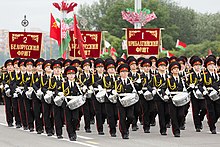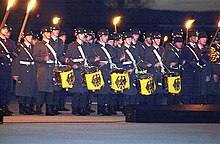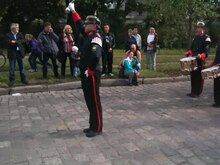marching band

A marching band or drum corps in the narrower sense of a music group consisting of marching drums , valveless flutes, lyres , bass drum and cymbals. It was mainly used in marching music and for signals. Today concert flutes, various percussion instruments and stick chimes ( marimba , glockenspiel ) are also used in many cases . Some marching bands have expanded their repertoire and see themselves as flute orchestras. They play arrangements of modern light music and sometimes also original compositions.
A drum corps was originally a pure drumming group. The marching band, to which the drum corps has become synonymous today, is led by a drum major. To do this, he gives the command signal during the march with the so-called Küs. It is a stick with a tip on one end and a ball on the other.
Musicians' trains can be used alone or together with other music groups, such as wind bands. Colloquially, the term minstrel march is also used for such combinations, then there are difficulties in distinguishing between brass bands, fanfare parades and drum corps.
History of the minstrel
The term minstrel and the right to piper can be traced back to the 8th century. Records from the 13th century indicate that the flute and drum were played together (a "spyl"). Horn, flute and trumpet signals are known from the military at an early stage (see fanfare (signal) ). Parades, combat and alarm exercises were carried out in lockstep, supported by the playing of flutes and other wind instruments as well as the beat of the drums.
In the German Army in the late 19th century, the marching band includes drummers and horn players of the infantry , which signals to give and marches had to play. Each company had two reels and two horn players equipped with horns and pipes . Minstrels in the cavalry were called trumpeters . Especially in the areas of Germany formerly occupied by French in the 19th century, the term drum choir or drum corps can also be found as a designation for musicians' trains , based on the aforementioned terms of French origin .
With the emerging gymnastics festivals and the associated parades, minstrel music also became an integral part of these festivals. It developed from the military origin of marching support to making music in concert. The minstrel was particularly promoted in the Workers' Gymnastics and Sports Association (ATSB), which included minstrels in its founding protocol in 1892. In 1922, 220 Hamburg minstrels in uniform white clothing appeared for the first time as a closed corps at the 1st Federal Festival of the ATSB in Leipzig. In 1925 the cultivation of concert music began in various minstrels' trains. In the same year, 2,000 minstrels provided the music for the 1st Workers' Olympics in Frankfurt / Main, in 1926 the ATSB National Gymnastics School opened in Leipzig with 4,200 miners and 6,500 miners made music at the 2nd National Gymnastics Festival of the ATSB 1929 in Nuremberg. At the end of 1932, 26,600 minstrels and 2,500 wind musicians were organized in the ATSB. This excellent work came to an abrupt end when the National Socialists came to power .
In the German Gymnastics Association (DT), the minstrel system remained almost insignificant for a long time until it was finally recorded as a separate field of activity at the federal level in 1928. At the end of 1932, around 8,000 minstrels and fanfare players were organized in the German Gymnastics Association. The German Gymnastics Association was transformed into the specialist office for apparatus gymnastics and summer games in the National Socialist Reich Association for Physical Exercise (NSDRL) and forcibly dissolved itself in 1936. This ended the gymnastics game for the time being.
In the time of National Socialism from 1933 to 1945, many marching bands were captured by the National Socialist Party for their self-expression and propaganda purposes. The marching bands of the SA and SS were important for the propaganda of the National Socialists. These marching bands performed at the Nazi party rallies in Nuremberg and at regional events. The concert area took a back seat.
With the beginning of the Second World War, these marching bands were no longer needed, and the musicians were drafted as soldiers. The minstrel system of the NSDAP expired after a relatively short time.
After the Second World War, minstrels came together to form state corps mainly in the northern German regional gymnastics associations. In 1951 the Bundesspielmannskorps of the German Gymnastics Federation, founded in 1950, emerged . At the German Gymnastics Festival in Hamburg in 1953, 2,200 minstrels performed, in 1958 in Munich there were already 3,000.
In the former GDR there was an independent association of gymnastics players within the German Gymnastics and Sports Federation (DTSB), the Music and Minstrels Association (MSV) in which the tradition of minstrels from the ATSB was continued after the Second World War. In 1990 the MSV joined the German Gymnastics Federation.
Numerous marching bands are also organized in the music departments of the German Shooting Association and the German Fire Brigade Association, some as musicians 'marches with whistles and drums, and others as minstrels' and fanfare marches.
Instruments
Originally, the minstrel trains belonged to cross pipes and drums . Since the Turkish wars , the lyre , the cymbal and the bell tree have also been used, which is why one speaks of Turkish music or Janissary music .
The classic marching band is content with these instruments, with only the soprano flute being used on the transverse pipes. In Germany, the Sandner Flute named after the manufacturer , also called the Magic Flute after the model , is most common. Until the 1960s, flutes made of grenadilla wood were mostly used. Today the flutes are made of metal or a mixture of metal and wood, e.g. B. the Klingson minstrel flute.
A classic marching band with an extended set of flutes also uses treble and alto flutes and tenor flutes. An extended percussion system with additional percussion instruments (bass drum, timpani , stick instruments ) is also being used more and more frequently.
Around 1954, the CES mood was developed in what was then the Federal Republic of Germany in order to better play old army marches in conjunction with brass band corps. Internationally, however, this CES / FES atmosphere remained unique. In the GDR, for example, they stayed with the B mood.
C-flutes are increasingly being made so that musicians can play together with other orchestras or record concert flutes.
| treble | Fes | F. | It |
| soprano | Ces | C. | B. |
| Old | Fes | F. | It |
| tenor | Ces | C. | B. |
If the percussion instruments take on the main role, the club is called Drummlercorps, or, following the North American model, drum corps , drum band or drumline .
A current development is the modernization of the instruments. In addition to flutes without flutes, musicians and drum flutes are used, either in addition or exclusively, with flutes. With the flutes in C and piccoli in C, new timbres are available. Alto flutes in G and bass flutes in C are also increasingly used. The percussion is expanded to include timpani, drum sets and percussion instruments ( e.g. cymbals , guiro , congas ). The stick games are supplemented by marimba , xylophone or vibraphone . Increasingly, musicians' trains that have an extended percussion and only flutes in C tuning see themselves more as a flute orchestra. Many clubs rename themselves accordingly.
Mixture of marching bands and fanfares
Minstrels' trains and fanfare trains were strictly separated in the military. This form of interplay, which has not yet had any role models from a music-historical point of view, is used in the Austrian and German minstrels' system: a mixture of pure musician's trains with pure fanfare trains and thus an interplay of flute, drum (various versions), lyre (or glockenspiel) ), Percussion and brass instruments such as trumpet / fanfare , sousaphone , horn in Eb or parforce horn in Eb / Bb.
Affiliation of the marching band
Germany
Minstrels often belong to clubs or organizations. Affiliation varies from region to region, more often marching bands belong to:
- Fire brigade (clothing color: blue);
- Shooting club (color of clothing: green);
- Gymnastics club (clothing color: gray / blue, blue / white or just white);
- Carnival club
- other clubs, some of which belong to a minstrel association (see category: brass music association )
Most of these associations are brought together at the federal level under the umbrella of the Federal Association of German Music Associations (BDMV) and through this membership also belong to the International Music Association CISM .
Sports game man's trains are mainly found in Saxony, Saxony-Anhalt, Thuringia and Berlin-Brandenburg. These marching bands were organized in the DTSB during the GDR . The classic uniform is white: white pants, white shirt, white shoes. The uniforms of Bavarian minstrel groups are often based on regional costumes or historical uniforms or are kept in the respective city colors. Many marching bands wear freely designed uniforms. Most marching bands follow the traditional uniform colors of their association.
The distribution area of minstrel music is predominantly the northern part of Germany. The southern part is mainly home to brass music in a wide variety of formations.
Some regional associations maintain minstrel groups / minstrel groups as representative selected orchestras, the members of which are made up of associations from the respective federal state.
Furthermore, the marching band has a long tradition in Germany. The Bundeswehr still maintains several marching bands in the military music service . B with the staff music corps of the Bundeswehr .
Minstrels is the collective term for the amateur musicians from the minstrel marches, fanfare marches, minstrels / fanfares marches, shawm bands / orchestras, music trains with predominantly flute or natural trumpet trimmings, bagpipe bands and the relatively new trend drum bands. For the most part, they can also be assigned to the “Marching Show Bands”; H. Without any genre differences they make music in march and / or show according to given criteria.
Austria
Impressed by the appearance and play of the German gymnastics players at the German Gymnastics Festival in Hamburg in 1953, the Austrian participants decided to set up miners' trains in their gymnastics clubs. The first Austrian marching band was founded in 1954 in the Turnverein Ried in 1848 at the instigation of Turnwart Sepp Schendl. Subsequently, the company was founded in Gmunden, Salzburg, Vienna and Linz. In Austria, however, there were only about 15 marching bands in 2000.
Organizationally, the minstrels' system was anchored in the Austrian Gymnastics Federation in 1965 through the establishment of a federal technical committee for minstrels within the framework of the federal gymnastics committee . Since 1987 it has been represented as a specialty directly in the Federal Gymnastics Council. The individual marching bands are specialist departments of the gymnastics clubs.
German-speaking Belgium
Minstrels' trains, sometimes also called minstrel associations in Belgium, are mainly found in the German-speaking community . There they are mostly independent clubs that do not depend on a shooting, sports or fire brigade company. Most of the marching bands in German-speaking Belgium belong to the East Belgian music association Födekam , which u. a. promotes cooperation between the individual associations.
Competitions
Every four years the German Orchestra Competition takes place, which is organized by the German Music Council and which has also been able to take part since 2000. The orchestra competition is preceded by a qualification at the state level.
Due to the numerous associations, there are various events that call themselves German championships , so each association can choose its "German master":
-
Federal Association of German Music Associations V.
- In 2007 the first “Open, Official German Championship of the BDMV” took place as part of the German Music Festival in Würzburg, the second in 2010 as part of the Rasteder Musiktage and the third in 2013 as part of the German Music Festival in Chemnitz. In 2016 the fourth German championship took place again in Rastede.
All players' clubs that are based in the Federal Republic of Germany and had qualified in the preliminary round were eligible to start.
- German Federal Association of Minstrels, Fanfare, Horns and Music Trains e. V.
- The "German Championship of the DBV" has been held every two years for over 30 years. Participants must qualify at the country level.
- German championship of the sports marching band
- The championship has been taking place since 1996. In 1996 and 1998 it was still called the Germany Cup of the Sportspielmannszüge. There is no division into classes, as the name of the event (sports team) already gives a specification.
See also
literature
- Elke Nebenführ: marching band. In: Oesterreichisches Musiklexikon . Online edition, Vienna 2002 ff., ISBN 3-7001-3077-5 ; Print edition: Volume 5, Verlag der Österreichischen Akademie der Wissenschaften, Vienna 2006, ISBN 3-7001-3067-8 .
- Günther Rambach: Swastika and Martinskirche. Fateful years in the Upper Palatinate. 1933-1959. Ensdorf 2010, ISBN 978-3-00-031635-7 .
- Leo Ertel, Dieter Frackowiak, Detlef Konrad-Preuß (eds.): Frohe Klänge. GDR minstrels then and after. Berlin 2014, ISBN 978-3-89793-190-9 .
- Hans-Walter Berg: Wind orchestra and minstrel corps in the Federal Union of German Wind and Folk Music Associations. BDBV Trossingen 1989, OCLC 247469406 .
Web links
- About the minstrels. A historical review Excerpt from: Festschrift 25 years of the Graz marching band. 1958–1983 , Graz 1983, author: Dr. Hansjörg Aigner (PDF file; 27 kB)
- 1848–1998: 150 years of musicians in German gymnastics from: Der Turnermusiker , issue 5/1998, author: Günther Schreeck (PDF file; 896 kB)
- After 23 years of struggle for existence: The end came out soon after the beginning : der tambour , issue 11–12 / 90, 1990, author: Bernd Schenke (PDF file; 1.38 MB)
- List of east Belgian marching bands on the website of the Födekam Music Association
Individual evidence
- ↑ The Military Music Service (PDF; 398 kB)



